A BRIEF HISTORY OF NEATH'S
YOUNG MEN'S CHRISTIAN ASSOCIATION
PHILIP JOHN
Early Years of Neath YMCA
The opening of a Neath branch of the Young Men’s Christian Association (commonly known as the YMCA, or simply the YM) lagged somewhat behind other Welsh towns. It was not until the end of June 1875 that a formal proposal to form a Young Men’s Christian Association was put to the populace of Neath in a preliminary meeting, which was attended by about 60 people, held at the Working Men's Institute and Club on Friday, 18th June 1875. The chief object of the proposed association was stated as the evangalisation of the people of Neath. Mr Arnee Frank Dymond[1] presided over the meeting which was reported as a great success. About 30 men enrolled on that evening with Mr John Coke Fowler, a stipendiary magistrate, being elected to the post of president.[2]
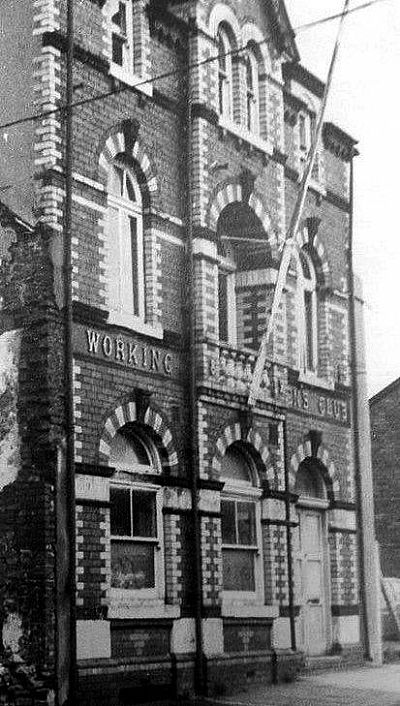
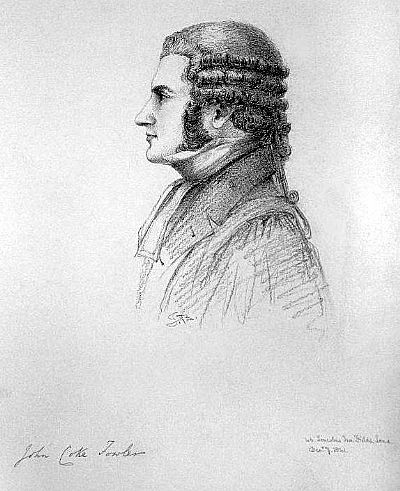
Neath Working Men's Club and portrait of John Coke Fowler
To begin with, and under the auspices of Neath YM, various meetings and talks were held to promote Christian values. Numerous venues, such as private houses, schools, Neath Town Hall and the Mechanics’ Institute were used for these events. For the purposes of evangelising the people, the town of Neath had been divided into seven districts for ‘cottage meetings,’ with a band of workers allocated to each district and with meetings held in each district every week. The meetings held in the mission houses, one on The Green (commonly known as the Green Mission) and one in Gold Street, were held on Sunday afternoons.
In 1876 the first public breakfast for young men, in connection with Neath YM, was given at the British Schools, Queen Street, Neath, when nearly 300 persons were seated; the cost being supplemented by donations from several residents in the town. The annual morning breakfast proved to be very successful, regularly attracting 300 people in subsequent years. Neath YM has maintained this tradition (possibly now a unique event in England and Wales) and since 1876 only ten years have been missed, seven during the 1940s when the event was suspended and three years as a consequence of the Covid-19 lockdown rules in the early part of the 2020s.[3]
In its annual meeting in October 1878 the members of Neath YM discussed the feasibility of taking rooms for a venue it could call its own. The consequence of taking rooms was that by October 1879 the Association’s annual report recorded a financial deficit of £20, which was the result of furnishing its rooms at 32 Queen Street; to recoup some funds one room was to be let as an office.[4] In the July Quarterly Meeting of 1880, the treasurer presented his accounts which were considered to be of a satisfactory character. The more pressing business was the election of committee members. Messrs Frank Dymond and Joseph Parry were elected joint secretaries, Mr William Byron was appointed treasurer and Mr Herbert Jones was appointed financial secretary; the necessity to fill vacancies on the committee was to become a regular occurrence at the Association’s meetings. In these early years those who held the post of President, after Mr Fowler, included: Charles Struve Price; William John Player and Frederick Joseph Gibbins.
District Administration – The Early Years in Wales
In October 1875 a conference was held in Cardiff to which delegates from various YMCA associations in South Wales and Monmouthshire were invited to attend. The outcome of the meeting was the formation of a South Wales District Association of YMCAs in connection with the parent society in London; members of the South Wales District Association were required to be persons who had an affiliation with a Christian church.[5]
 At a conference of the South Wales District Association, held in Neath in April 1880, the memberships reported for the associations present were as follows: Cardiff 180 (founded in 1852), Newport 120 (founded 1869), Swansea 100 (founded 1868) and Neath 100. At this conference it was decided to form a union of the district associations present. Mr James F Fawckner was appointed president and Mr AF Dymond, was appointed honorary secretary, of the newly formed South Wales District Union of Young Men's Christian Associations. By the time of the first annual conference of the Union, held in Cardiff in September 1880, Neath had increased its enrolled membership to 154 and Swansea to 110.[6] At the next annual conference, Arnee Frank Dymond announced he would be moving to work with the Worcester YM. A succession of travelling secretaries were appointed up until 1896 when the Welsh speaking Rev. Richard Daniel Thomas was appointed to South Wales District. In his annual report, published in 1898, he reported that he had visited 37 centres and the association in Neath was one of the largest and most excellent in South Wales.[7]
At a conference of the South Wales District Association, held in Neath in April 1880, the memberships reported for the associations present were as follows: Cardiff 180 (founded in 1852), Newport 120 (founded 1869), Swansea 100 (founded 1868) and Neath 100. At this conference it was decided to form a union of the district associations present. Mr James F Fawckner was appointed president and Mr AF Dymond, was appointed honorary secretary, of the newly formed South Wales District Union of Young Men's Christian Associations. By the time of the first annual conference of the Union, held in Cardiff in September 1880, Neath had increased its enrolled membership to 154 and Swansea to 110.[6] At the next annual conference, Arnee Frank Dymond announced he would be moving to work with the Worcester YM. A succession of travelling secretaries were appointed up until 1896 when the Welsh speaking Rev. Richard Daniel Thomas was appointed to South Wales District. In his annual report, published in 1898, he reported that he had visited 37 centres and the association in Neath was one of the largest and most excellent in South Wales.[7]
Over the decades Neath YM figured prominently in the Welsh National Council of YMCAs (until its demise in 2014) having its Board members elected to the Executive Committee. Since December 2014 YMCAs in Wales have been part of the National Council of YMCAs (which also includes YMCAs in England).
Neath YMCA Home Ownership
In June 1883 the half-yearly meeting of the South Wales Union of YMCAs was held at Neath, by which time the association was in residence at 19 Queen Street. During the meeting it was suggested that the time had arrived when a ‘home for young men’ should be founded in Neath. The amount necessary to bring this about was estimated at £1,000 upon which Mr John Cory (representing Cardiff YM) offered to subscribe £200 provided the sum of £8OO was raised by Neath YM. At the beginning of June 1884 both No. 18 and No.19 Queen Street were advertised for sale by auction. To raise funds for the purchase of the Queen Street properties a circular soliciting subscriptions in aid of providing a ‘Home’ was posted around the town of Neath. Over the ensuing months various events were held to raise moneys to alleviate the debt the Association incurred as a result of the purchase of the properties and consequently No. 18 Queen Street was rented out.[8]
In 1896 Gilbert Frances Scale and his sister Alice Mary Scale sold to the Trustees of Neath YM [15 trustees in total] the freehold of the property known as No. 8 Orchard Place, Neath, for the sum of £1,000. In 1906 Neath YM sold the property it had occupied in Queen Street for £390.
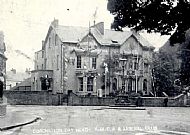 Partly due to its new facilities, at Orchard Place, Neath YM was able to increase its membership year-on-year, but the increase in revenues was frequently exceeded by the ever-increasing maintenance costs of an old building. Nevertheless, in 1950 an ambitious scheme proposed to demolish the all-purpose timbered hut [the gymnasium] to the rear of the property and build in its place a large gymnasium and changing rooms. However, the scheme never came to fruition due to the deteriorating state of the main building. The annual report for 1958 -1959 records that the building was in a very bad state of repair, despite many alterations and repairs being carried out during the year.
Partly due to its new facilities, at Orchard Place, Neath YM was able to increase its membership year-on-year, but the increase in revenues was frequently exceeded by the ever-increasing maintenance costs of an old building. Nevertheless, in 1950 an ambitious scheme proposed to demolish the all-purpose timbered hut [the gymnasium] to the rear of the property and build in its place a large gymnasium and changing rooms. However, the scheme never came to fruition due to the deteriorating state of the main building. The annual report for 1958 -1959 records that the building was in a very bad state of repair, despite many alterations and repairs being carried out during the year.
In October 1960 the secretary of Neath YM resigned and was not immediately replaced. An accident to the YM’s caretaker in January 1961 compounded the difficulties that the Association was facing as a result of an unusually long period without the leadership of a secretary. It was as a result of this predicament that the management committee felt that, purely as a temporary measure, until a secretary was appointed, they would have to suspend its activities. On 6th February a special meeting of the management committee was called and the chairman, Mr Brynmor Morris, announced that a suitable candidate for the post of secretary had been found – Mr William Collier, secretary of Aberaman YM, was appointed secretary of Neath YM in March 1961.
It was in 1961 that the Neath YM moved to the old Neath Union Workhouse known as Lletty Nedd in Pen-y-Dre. These premises were in a dilapidated state, outwardly a grim in appearance and would need a considerable amount of work before they could occupy them. Lletty Nedd was officially opened as the new YM home on 20th October 1961 by Lord Aberdare.
In 1962 the Association sold No. 8 Orchard Place to Chaucer Estates Ltd for £8,250. The proceeds of the sale were used to purchase No. 6 Bracken Road and Lletty Nedd Workhouse.[9] The ancient workhouse buildings were used until 1966 when the Phase One of the re-building project was completed. The foundation stone of the new building was laid by Mr Martin Evans-Bevan, in the unavoidable absence of his father Sir David Martin Evans- Bevan.
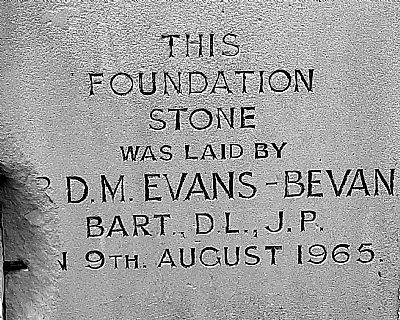
On 10th June 1966 Sir Cennydd Traherne, Lord Lieutenant of Glamorgan officially opened the first phase of the new building which had been erected alongside the old workhouse previously occupied by Neath YM. That first phase, built over the site of the Casuals Ward, cost £30,000.[10] In September 1968 the 130-year-old bake house at Lletty Nedd, which had housed the YM, was demolished to make way for the Phase Two of the re-building project. The second phase building was again officially opened by Sir Cennydd Traherne, Lord Lieutenant of Glamorgan on 2nd December 1970.
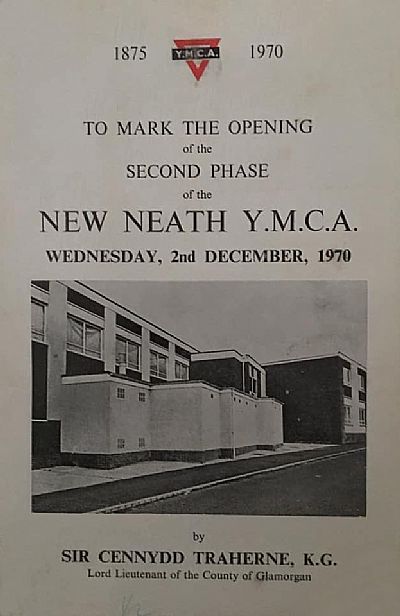
The new premises soon became a cause for concern as highlighted in a report in 1973, by the then general secretary of three weeks, Leonard Jenkins. His report stated that plaster was falling off the lintels of doors and that the changing rooms and showers were in an appalling condition due to water leaking through the flat roof, the condition of which was shocking. Vandalism [graffiti] carried out by a small group of members, had badly marked corridors and rooms.
To better cater for it members the Association continually sought to improve its facilities, as was the case in 1977, when minor modifications to the building revealed damage to the roof over the gymnasium. The deteriorating condition of the roof was to remain the main concern over the coming years and in 1988 the leaking roof was once again causing serious damage to the internal fabric of the building (as was penetrating damp through the walls of the building). The roof was eventually replaced in 2014 at a cost well exceeding £35,000. Over the years the purpose built premises at Pen-Y-Dre have been repaired/modified/added too, as funding permitted.
The War Years
During WWI few organisations did as much for the comfort of Tommy Atkins as the Young Men’s Christian Association, and a substantial number of letters written home, by Tommy, points to this.[11]
As soon as war was declared local YMCAs swung into action, accompanying the local ‘Terriers’ to their postings they set up their welfare tents and huts; the scope of involvement rapidly expanded with the YMCA following the troops to the front line. However, the YMCA soon found that their resources were stretched to breaking point. They required a great deal of money to pay for the equipment, staff, subsidised meals, entertainment and items they provided for troops such as writing paper, books, postage and soap. As a consequence of this dilemma committees were rapidly established by local YMCAs to raise substantial sums to support this work. Neath YM played its part, organising Flag Day collections to raise money to help cover these costs and also for a Neath and District YMCA Hut. In addition to fundraising for the welfare of service men, Neath YM offered free accommodation at their Orchard Street premises for members of the forces who had missed their connections to the valleys. Two members of the YM would meet the late trains each evening and invite friendless service men to stay the night at the YM premises in Orchard Place where they would receive a supper and breakfast.
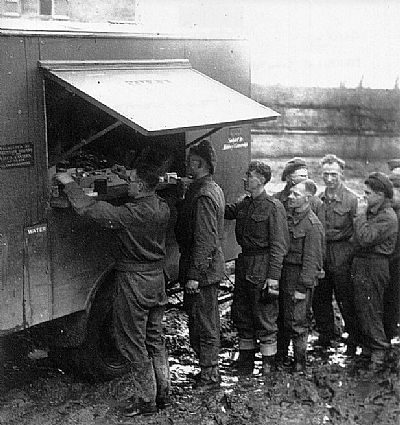
Neath YMCA mobile canteen in Normandy
At the outbreak of World War 2 the YMCA was once again called upon to undertake social and welfare work for troops, both at home and overseas. The immediate response of Neath YM was to give uniformed men in the district the use of the YM’s rooms in Neath for the purpose of resting, reading or writing. In 1941 Mr DM Evans-Bevan, in recognition of the difficulties under which they worked, presented Neath YMCA Ladies' Canteen Committee with a mobile canteen. The mobile canteen was used to visit troops scattered about the area and visit locations which had suffered bomb damage following Luftwaffe air raids. In July 1942 Neath YM undertook to provide a service hut at an RAF Station [RAF St Athan] at an estimated cost of £2,500. By December 1942 the amount raised was in excess of £2,900 and with contributions outstanding the total raised was expected to exceed £3,000; the erection of the hut (which was known as the Neath Borough and Rural District YMCA Hut) was completed in October 1943. Next on the agenda for the ladies of Neath YM Canteen and Mobile Canteen was the provision of a mobile canteen for troops serving overseas. The canteen, which cost £1,000, was shipped to Normandy in July 1944 after the sum of £500 was raised at a fete held in the grounds of Glyn Clydach.
In 1940 the traditional Good Friday Breakfast was held but some minor adaptions were incorporated. Firstly, owing to food rationing it was not possible to offer the usual breakfast fair and secondly, members of the HM Forces were welcome to attend. The next Good Friday Breakfast was held post-war, in 1948, when due to rationing restrictions the number able to attend was limited to 60 ticket holders. At the 1941 annual meeting it was reported that 24 members of Neath YM were serving with the Armed Forces and more members would join the fray in the following years.
Post World War Two
From 1947, as well as housing the caretaker, the YM’s building in Orchard Place became the home of the post-holder of the secretary of the Association.
The first Annual Meeting since the end of World War II was held on the 11th March 1949 when it was announced that the previous year’s loss had been turned into a credit balance and that the current membership stood at 115; there were also 44 annual subscribers to the Association and there were 30 ladies assisting in the canteen. The financial situation of Neath YM would fluctuate from year to year – the balance sheet for the year ending 31st March 1952 showed a deficit even though membership had increased to 200. In February 1961 the membership, which now included boys and girls over the age of 13, stood at 400 and with the opening of their Lletty Nedd premises the membership numbers increased to 450.
In 1978 the Association adopted a new committee structure to manage its affairs – a Board of Management consisting of 60% full members (those who confirm their Christian beliefs) and 40% associate members. It was intended that this board would meet several times a year but the executive work would be done in committees.
Sport, Education and Culture at Neath YMCA
During the 1870s YMCAs not only promoted evangelical Christianity, some also advocated good sportsmanship in athletic contests and the use of gymnasiums. This view point was shared by Neath YM and so in July 1883 the Association organised an event they hoped would kick-start interest in personal fitness and increase their membership. An ‘Assault at Arms’ performed by 70 members from the Swansea YM Gymnasium was successfully held at the Alderman Davies School. The event did the trick and young men signed up to the Neath YM Gymnasium. A second ‘Assault at Arms’ at Neath, was given by about 50 members of the Swansea YM Gymnasium, only this time the venue was the gymnasium of the Neath YM. The Assembly Room, built by the proprietor, Mr Robinson, of Neath, had been adapted for gymnasia. The first ‘Assault at Arms’ given by the members the Neath YM Gymnasium took place in February 1884, at Robinson’s Assembly Rooms, Neath. Sadly, owing to a reported financial difficulty, the Neath YM Gymnasium section was abruptly discontinued before the end of the year.
The requirement for the town of Neath to have a gymnasium was once again raised in 1892 after 80 young men signed a petition stating that they would become members of a gymnasium club. Several of the Neath YM committee attended a meeting which was called to establish how and where a gymnasium might be started. Walter Griffith Hibbert suggested that the necessary building for a gymnasium should be erected at the back of the YM building in Queen Street. However, it was not until 1895 when due to an increase in membership that Neath YM stepped forward with a proposal to extend it premises in Queen Street and erect a gymnasium.[12] This proposal was subsequently abandoned when Orchard Place became available and was acquired by the Association. As a consequence of the acquisition the formation of a gymnasium section was temporarily put on hold.
Driven by Walter Griffith Hibbert, president of the Association and with enthusiastic support from Mrs Hibbert, a ‘gymnasium scheme’ to raise money for its construction was launched. Funded by donations and the monies from bazaars organised by the ‘lady friends of Neath YM,’ the prospect of having a gymnasium was realised when in March 1899 the Association submitted a planning application for the erection of a gymnasium at Orchard Place.[13] The cornerstone of the new gymnasium was laid by Mrs Caroline Angharad Hibbert, wife of the president, in the presence of a large number of ladies and gentlemen, on Monday, 17th July 1899.[14]
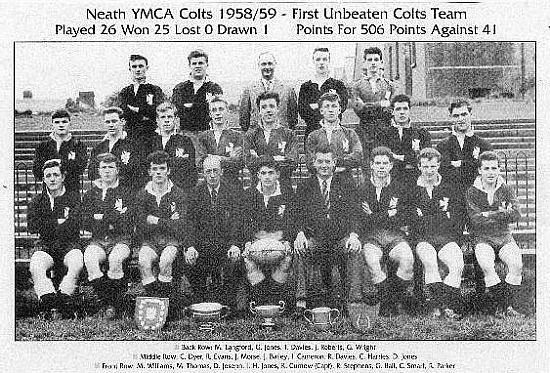
Over the decades Neath YM has provided health and wellbeing facilities, including gyms, community halls, and outdoor activities that cater for all ages, from pre-school children through to senior citizens. In keeping with modern day technology there are, of course, computer aid classes and Workways schemes to assist people in obtaining jobs. The Association has arranged lectures on various subjects such as: religion, the biographies of historic and academic figures, Welsh hymnology to name but a very few. The titles of the classes give a reasonable indication of the nature of the activities, the exception being the ‘Insanity’ class, which was so labelled because of the excess physical effort required by the participants.
Under the auspices of the Association world famous artists, such as Richard Tauber, Beatrice Harrison and Paul Robeson have performed in Neath.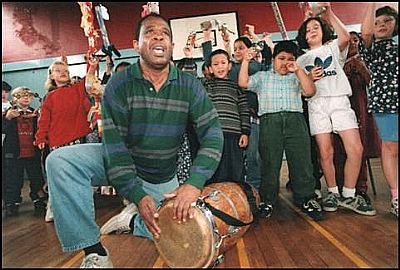
Alex Pascall OBE – one of the developers of the Notting Hill Carnival – pictured leading a session of Caribbean music and dance at Neath YM in preparation for the 1997 Neath Festival.
In recent years collaboration with a wide range of community organisations, agencies and partnerships, both in the private and voluntary sectors, allowed the Association to develop a diverse portfolio of classes across a broad range of age groups. Partnership working supported existing and new programmes and in November 2006 the Association was awarded the Prince of Wales Silver Rose Bowl Cup for its work in the community.
REFERENCES AND NOTES

